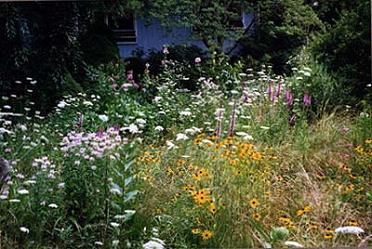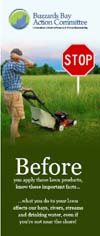Environmentally Sound Lawn Care
So you want a nice looking yard, a green lawn, and pleasant landscaping. Are there ways to do this to minimize impacts to surface waters, wetlands, groundwater, and the environment?You bet!
For more tips on lawn care, read our Lawn Care Brochure.
Limit or eliminate fertilizer use
Many well-maintained lawns do not need any fertilizer at all. Use the results of a soil test (Umass Soil Testing or Cape Cod Extension Testing) and the types of grass you have planted determine how much fertilizer you need. Time your applications carefully, and never apply fertilizers before heavy rain or when cold weather is expected. Only fertilize in the fall or early spring.Limit or eliminate pesticide use
Ask yourself if you really care if there are a few dandelions or weeds on your lawn. Are grubs really at a density that they are affecting the appearance of your lawn? Use pesticide-containing products wisely and follow human health and environmental safety precautions. If you really don't need pesticides, use fertilizer only lawn products.Lime your lawn
Most soils in our area are acidic, and overly acidic soils are often the cause of a poor looking lawn or stifle the growth of grass. People may mistake these poor acidic soil conditions for under-fertilization, when adding lime to the soil can solve the lawn problem. Lime is generally applied to lawns at a rate of about 50 pounds per 1000 square feet, but the amount you need should be determined for your lawn by a pH test (test your soil). Apply lime in the fall. Don't lime near plants which need acidic soil, such as azaleas or rhododendrons.Test your soil
A soil test identifies the nutrients already present in your soil, so you only apply the right amounts of what your soil needs. It will also tell you if you need to add lime. For more information, call the UMASS Soil Testing Lab at (413) 545-2311 or visit the Cape Cod Extension Service website Plant and Soil Clinic Hotline.Buildup your loam layer
If your area has sandy soils (like Cape Cod and northern portions of the Buzzards Bay watershed), lawns can easily dry out. Supplement your topsoil so you have at least 6 inches of loam (although 8 inches is better). A thick layer of loam will dramatically cut down your need for watering and fertilizing your lawn, and help reduce the spread of weeds.Use the right grass
Native grasses (or drought and disease tolerant species) require less water, fertilizer, and pesticides than non-native species. In sandy soil areas around Buzzards Bay, plant a mix of fine-leafed or red fescues and perennial rye grass. These seed mixtures are low maintenance, easy to grow, drought resistant, and require less fertilizer than other grasses. Local garden stores often sell this grass mixture as a "Cape Cod" seed mix. Other species like Kentucky Blue Grass may require twice as much water and fertilizer to keep green.Handle lawn chemicals carefully
Many of the lawn products these days contain not only fertilizer, but insecticides, and herbicides. Neither fertilizer nor pesticides should ever be applied near surface waters, or where stormwater runoff discharges to surface water over land or through pipes. Collect any spilled pesticides or fertilizer. Don't apply chemicals to paved areas, it just gets washed to surface waters or gets added to the groundwater and where it could possibly affect drinking water.Mulch gardens and shrub areas
Mulching your gardens and shrub areas with 4 or more inches of mulch can greatly reduce or eliminate the need to water these areas, and will also reduce the need to weed these areas. Mulching also helps recycle construction demolition materials because old wood framing is now shredded and dyed and is one of the most popular mulch materials today.Keep it mowed
Don't let your grass get too tall. Most experts recommend a mower height of 2 inches, and cutting when the grass reaches 3 inches. If frequently mowed, grass clippings can be left on the lawn to form a layer of thatch to help conserve moisture.Use more naturalized landscapes
Lawns are great for kids to play on and can be nice to look at. They can also cost a lot of money and time to maintain. Don't need or want a big lawn anymore? Have the kids grown up and you want a new look for your yard? Consider naturalizing more areas of your property with wildflowers, trees, or shrubs.
Maintain vegetation buffers
Maintain a strip of natural vegetation betweens your lawn and any adjoining wetlands or surface waters. This vegetated buffer zone will help filter and trap nutrients before they are able to reach the water, as well as help prevent erosion.Minimize watering
In southeast Massachusetts, there is generally sufficient rainfall so that watering of lawns is not necessary. If you wish to maintain your lawn's green appearance during a hot and dry summer periods, water your lawn once a week (twice if necessary) with 1 inch of water to avoid the onset of dormancy (set out a small tin can to measure how much you are really watering). Water early in the morning in an effort to minimize the spread of disease, and evaporation of water into the air.BBAC lawn tips brochure
For more tips on lawn care, read our Lawn Care Brochure.Additional resources
University of Massachusetts Turf Care websiteCommonwealth of Massachusetts Department of Agriculture lawn care for pesticide applicators brochure
USDA Lawn and Garden Tips
Massachusetts Organic Accredited Land Care Professionals

